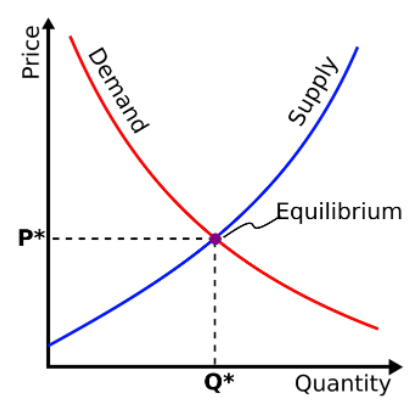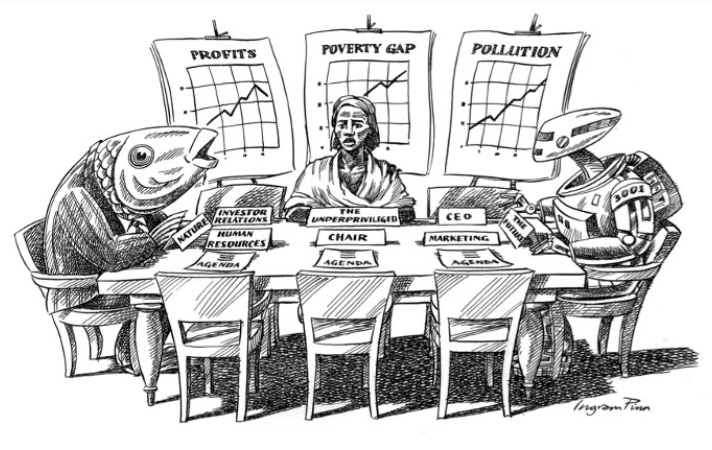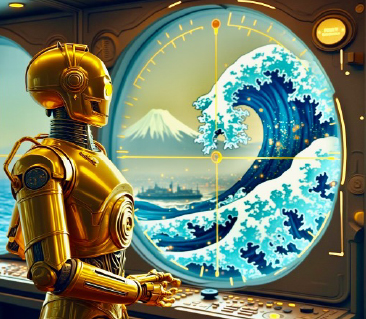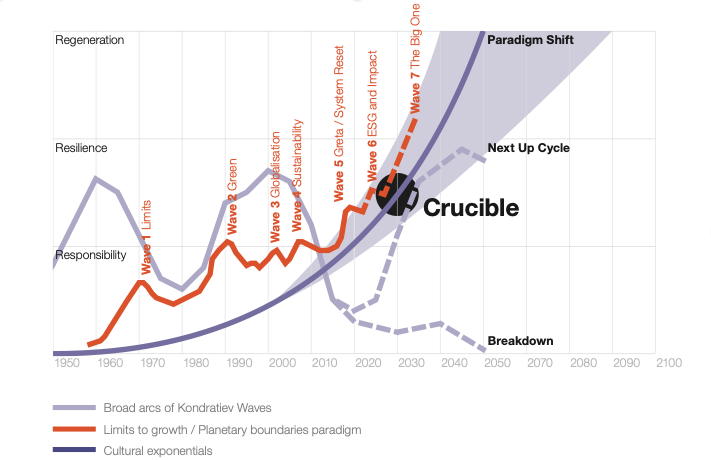Worldview

A different sort of X-curve: demand and supply in equilibrium
(source: SilverStar 2006, via Wikipedia)
Sometimes described as an economist, I’m anything but. Economists love their equilibrium points, but I confess I struggled to find my own equilibrium in the world of microeconomics.
I dropped out after one year of university economics in 1968, a pivotal year in politics and civil society. Already moving counter current, I began exploring incoming societal changes in a world itself very far from equilibrium.
But that year was not wasted: two basic economic concepts stuck in my mind. First, as explained in the panel below, supply and demand curves, and, second, the cycles and waves that shape our economies.
Multiple bottom lines
The two ideas that stayed with me after university economies were supply and demand curves; and second, the macroeconomic waves of creative destruction and reconstruction mapped by Nikolai Kondratiev and Joseph Schumpeter (echoed in my ever-evolving Waves map under Worldview).
As I merged those curves (relatively simple for the mathematically inclined) with new types of waves (pretty complicated, even for the mathematically inclined), I introduced the idea of multiple bottom lines—a term I first encountered in Alvin Toffler’s 1980 book, The Third Wave.
With concepts like the ‘triple bottom line’ and ‘green growth,’ I aimed to give tomorrow a more powerful voice in today’s business discussions and decisions—as indicated in a cartoon I commissioned from Financial Times cartoonist Ingram Pinn back in 1991. These days, environmental and societal issues are still muted, whereas the robot’s voice (think Big Tech, AI and the like) grows ever stronger.

Unheard voices in boardrooms
(source: Ingram Pinn, 1991)
Focusing on business
A key question for me early on was whether I should focus on cities or on business and markets. After a postgraduate degree in city planning at UCL, I began work in 1974 with John Roberts at TEST (Transport & Environment Studies) on environmental impact assessments in Egypt and Singapore, and on pedestrianization schemes across the UK.
But throughout that period, I wrote regularly for New Scientist on how business was coming to grips with the environmental agenda. Eventually, the choice was made. Then, as what we would now call a serial entrepreneur, I founded or co-founded several enterprises
- ENDS: Building out from my New Scientist writing, I co-founded Environmental Data Services (ENDS) in 1978, alongside David Layton of Incomes Data Services (IDS) and WWF co-founder Max Nicholson. I was founding editor of The ENDS Report, then managing director of ENDS. At the time, it seemed impossible to engage boards on our issues, though soon we had begun to turn the corner.
- JEA/Countercurrent: In 1983, I founded my own consulting firm, John Elkington Associates (JEA), pioneering in corporate environmental advisory work. This later evolved into Countercurrent, supporting all 21 of my book projects to date. On launch, it seemed virtually impossible to engage consumers on green issues. But our 1988 book The Green Consumer Guide changed that.
- SustainAbility: In 1987, I co-founded SustainAbility with Julia Hailes, which took on—and radically expanded—JEA’s consulting portfolio. It seemed very unlikely that business leaders would embrace multiple bottom lines, but my concept of the triple bottom line helped move the needle. Much later, as our agenda mainstreamed, SustainAbility was acquired by ERM, largely owned by the private equity firm KKR.
- Volans: Next, in 2008, I co-founded Volans with Pamela Hartigan, Sam Lakha, Geoff Lye and Charmian Love. The seemingly impossible challenge we embraced this time was ‘system change.’ With Louise Kjellerup Roper as the agency’s longstanding CEO, that remains our goal—and I now serve as Founder & Global Ambassador.
Rewilding markets
Next, comes adventure #5, involving a radical refresh of Countercurrent. Late in 2024, I began rebooting the most personal of my enterprises as a platform for evolving work on next generation solutions—discovering along the way that the number 5 is powerfully symbolic, representing curiosity, change and freedom.
For a sense of where my brain is headed, which is into mindset and paradigm territory, take a look at my Substack channel, Rewilding Markets.
The symbolism of X, as in X-curves, is more chequered—especially since Musk parasitized Twitter. But, for me, X still symbolizes ambition, innovation, disruption, and the embrace of the unknown (see ‘X factor’ panel under Worldview).

Hi-Vis: with Volans CEO Louise Kjellerup Roper in Eire
(source: Volans, 2023
It really doesn’t matter how hard you work, or how fast you travel, if you are headed in the wrong direction. So, what’s the right direction here? Over time, I have evolved (and tested widely) a personal worldview, a mental model, that frames all my work.
Among other things, it suggests an overall direction of travel. But it also assumes that, while there are times when things go in straight lines, there are times when they don’t. And we are headed into times where they won’t.
I explained the model’s evolution in my 2020 book, Green Swans—and developed the thinking further in 2024’s Tickling Sharks. The conclusion: we have entered an historic ‘U-Bend,’ where an old order fragments and new ones struggle to find their feet.
As Limits to Growth co-author Donella Meadows put it, the world’s most powerful change levers link to paradigm shifts. Luckily, I conclude, we are now experiencing the late stages of a paradigm shift that began around the time I was born.

Successful navigators see things others don’t, can’t or won’t
(source: JE via Artiphoria)
Breakdowns and breakthroughs
In the Waves map below, the macroeconomic context is sketched in the blue-gray line, leading either to breakdowns or breakthroughs. My sense is that we will see both outcomes, depending on where in the world we happen to find ourselves.

Waves and Delta map
(source: John Elkington/Rupert Bassett for SustainAbility/Volans, 1994-2025)
The model moves from basic Responsibility strategies through approaches ensuring greater Resilience, then finally to Regeneration—where we invest to rebuild our environmental, economic, social and political systems to ensure their long-term health.
Ups and downs
We must expect profound ups and downs, waves of creative destruction which drive periods of intense investment and disinvestment. But we should also be clear that two things are now happening simultaneously.
First, the sustainability agenda is increasingly contested, as with the ongoing ‘ESG recession’ and the Trump 2.0 team’s fervent denial of climate science. The incumbent corporate dinosaurs sense their demise coming—and are fighting back.
It’s rarely a good idea to try to stop the future, even for those with interests vested or capital sunk in the old order.
Second, the underlying trajectories are accelerating, driving us toward various forms of breakdown alongside the next up cycle, with unfathomable macroeconomic and geopolitical implications.
Some people will ride this emerging wave better than others. Witness China’s strategic and tightening grip of the commanding heights of tomorrow’s economy, ranging from rare earth minerals and the solar-wind-batteries nexus, through electric vehicles to AI, drones, robotics and stealth aircraft.
Into the Crucible
As this set of societal pressure waves (the orange line) build and fade, citizens increasingly sense that our old model is failing. Many seek comfort in populism, but too often the politicians they vote for are blind to leading edge science in areas like planetary boundaries.
Result: we are heading into the Crucible zone, where past, present and future slug it out for dominance. Surfers of big waves dread this space, where you can be trapped underwater and “ragdolled” by forces beyond your control.
On the upside, some of us are now getting ready to head into the ever-expanding Delta of transformative change (the gray-blue fan extending out to 2090). A central challenge in all of this: inserting the ‘X factor’ (see panel) into tomorrow’s sustainability agenda.
To quote Charles Dickens, these will be the best of times, the worst of times. An age of foolishness, an age of wisdom. And, already forming, a seventh societal pressure wave, maybe even a set of tsunamis. For the moment, let’s label this zone “the Big One.”
The X factor
For me, the ‘X’ story began in the late 1950s and early 1960s. As an Air Force child, I adored experimental aircraft, from Schneider Trophy planes to the X-15, flown by the likes of Chuck Yeager. This rocket-with-wings went where there was so little atmosphere that it lost traction and span out of control. The very essence of Tom Wolfe’s 1979 space race book, The Right Stuff.
The story rebooted when I visited Wired’s Senior Maverick Kevin Kelly in Pacifica, California, on April 13, 2005. His books Out of Control and New Rules for the New Economy had already had a profound influence on my own thinking.
Before long, I was also visiting a number of other X-factor hubs, among them Singularity University (now plain Singularity), GoogleX (now known as X, or “the moonshot factory”) and the XPRIZE Foundation.
I distilled some of this into 2016’s X-themed Volans report for the Business & Sustainable Development Commission, Breakthrough Business Models. We showed various forms of positive change going exponential. This then fed into our Project Breakthrough work with the UN Global Compact.

X-15 in the 1960s
(source: US Air Force, via Wikipedia)
